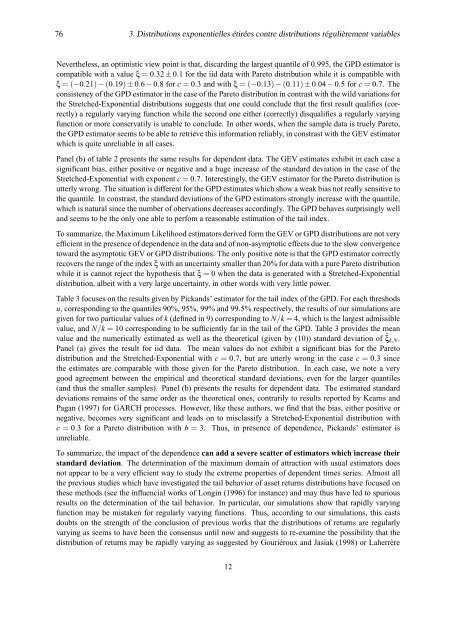statistique, théorie et gestion de portefeuille - Docs at ISFA
statistique, théorie et gestion de portefeuille - Docs at ISFA
statistique, théorie et gestion de portefeuille - Docs at ISFA
Create successful ePaper yourself
Turn your PDF publications into a flip-book with our unique Google optimized e-Paper software.
76 3. Distributions exponentielles étirées contre distributions régulièrement variables<br />
Nevertheless, an optimistic view point is th<strong>at</strong>, discarding the largest quantile of 0.995, the GPD estim<strong>at</strong>or is<br />
comp<strong>at</strong>ible with a value ξ = 0.32 ± 0.1 for the iid d<strong>at</strong>a with Par<strong>et</strong>o distribution while it is comp<strong>at</strong>ible with<br />
ξ = (−0.21) − (0.19) ± 0.6 − 0.8 for c = 0.3 and with ξ = (−0.13) − (0.11) ± 0.04 − 0.5 for c = 0.7. The<br />
consistency of the GPD estim<strong>at</strong>or in the case of the Par<strong>et</strong>o distribution in contrast with the wild vari<strong>at</strong>ions for<br />
the Str<strong>et</strong>ched-Exponential distributions suggests th<strong>at</strong> one could conclu<strong>de</strong> th<strong>at</strong> the first result qualifies (correctly)<br />
a regularly varying function while the second one either (correctly) disqualifies a regularly varying<br />
function or more conserv<strong>at</strong>ily is unable to conclu<strong>de</strong>. In other words, when the sample d<strong>at</strong>a is truely Par<strong>et</strong>o,<br />
the GPD estim<strong>at</strong>or seems to be able to r<strong>et</strong>rieve this inform<strong>at</strong>ion reliably, in constrast with the GEV estim<strong>at</strong>or<br />
which is quite unreliable in all cases.<br />
Panel (b) of table 2 presents the same results for <strong>de</strong>pen<strong>de</strong>nt d<strong>at</strong>a. The GEV estim<strong>at</strong>es exhibit in each case a<br />
significant bias, either positive or neg<strong>at</strong>ive and a huge increase of the standard <strong>de</strong>vi<strong>at</strong>ion in the case of the<br />
Str<strong>et</strong>ched-Exponential with exponent c = 0.7. Interestingly, the GEV estim<strong>at</strong>or for the Par<strong>et</strong>o distribution is<br />
utterly wrong. The situ<strong>at</strong>ion is different for the GPD estim<strong>at</strong>es which show a weak bias not really sensitive to<br />
the quantile. In constrast, the standard <strong>de</strong>vi<strong>at</strong>ions of the GPD estim<strong>at</strong>ors strongly increase with the quantile,<br />
which is n<strong>at</strong>ural since the number of oberv<strong>at</strong>ions <strong>de</strong>creases accordingly. The GPD behaves surprisingly well<br />
and seems to be the only one able to perfom a reasonable estim<strong>at</strong>ion of the tail in<strong>de</strong>x.<br />
To summarize, the Maximum Likelihood estim<strong>at</strong>ors <strong>de</strong>rived form the GEV or GPD distributions are not very<br />
efficient in the presence of <strong>de</strong>pen<strong>de</strong>nce in the d<strong>at</strong>a and of non-asymptotic effects due to the slow convergence<br />
toward the asymptotic GEV or GPD distributions. The only positive note is th<strong>at</strong> the GPD estim<strong>at</strong>or correctly<br />
recovers the range of the in<strong>de</strong>x ξ with an uncertainty smaller than 20% for d<strong>at</strong>a with a pure Par<strong>et</strong>o distribution<br />
while it is cannot reject the hypothesis th<strong>at</strong> ξ = 0 when the d<strong>at</strong>a is gener<strong>at</strong>ed with a Str<strong>et</strong>ched-Exponential<br />
distribution, albeit with a very large uncertainty, in other words with very little power.<br />
Table 3 focuses on the results given by Pickands’ estim<strong>at</strong>or for the tail in<strong>de</strong>x of the GPD. For each threshods<br />
u, corresponding to the quantiles 90%, 95%, 99% and 99.5% respectively, the results of our simul<strong>at</strong>ions are<br />
given for two particular values of k (<strong>de</strong>fined in 9) corresponding to N/k = 4, which is the largest admissible<br />
value, and N/k = 10 corresponding to be sufficiently far in the tail of the GPD. Table 3 provi<strong>de</strong>s the mean<br />
value and the numerically estim<strong>at</strong>ed as well as the theor<strong>et</strong>ical (given by (10)) standard <strong>de</strong>vi<strong>at</strong>ion of ˆ ξk,N.<br />
Panel (a) gives the result for iid d<strong>at</strong>a. The mean values do not exhibit a significant bias for the Par<strong>et</strong>o<br />
distribution and the Str<strong>et</strong>ched-Exponential with c = 0.7, but are utterly wrong in the case c = 0.3 since<br />
the estim<strong>at</strong>es are comparable with those given for the Par<strong>et</strong>o distribution. In each case, we note a very<br />
good agreement b<strong>et</strong>ween the empirical and theor<strong>et</strong>ical standard <strong>de</strong>vi<strong>at</strong>ions, even for the larger quantiles<br />
(and thus the smaller samples). Panel (b) presents the results for <strong>de</strong>pen<strong>de</strong>nt d<strong>at</strong>a. The estim<strong>at</strong>ed standard<br />
<strong>de</strong>vi<strong>at</strong>ions remains of the same or<strong>de</strong>r as the theor<strong>et</strong>ical ones, contrarily to results reported by Kearns and<br />
Pagan (1997) for GARCH processes. However, like these authors, we find th<strong>at</strong> the bias, either positive or<br />
neg<strong>at</strong>ive, becomes very significant and leads on to misclassify a Str<strong>et</strong>ched-Exponential distribution with<br />
c = 0.3 for a Par<strong>et</strong>o distribution with b = 3. Thus, in presence of <strong>de</strong>pen<strong>de</strong>nce, Pickands’ estim<strong>at</strong>or is<br />
unreliable.<br />
To summarize, the impact of the <strong>de</strong>pen<strong>de</strong>nce can add a severe sc<strong>at</strong>ter of estim<strong>at</strong>ors which increase their<br />
standard <strong>de</strong>vi<strong>at</strong>ion. The d<strong>et</strong>ermin<strong>at</strong>ion of the maximum domain of <strong>at</strong>traction with usual estim<strong>at</strong>ors does<br />
not appear to be a very efficient way to study the extreme properties of <strong>de</strong>pen<strong>de</strong>nt times series. Almost all<br />
the previous studies which have investig<strong>at</strong>ed the tail behavior of ass<strong>et</strong> r<strong>et</strong>urns distributions have focused on<br />
these m<strong>et</strong>hods (see the influencial works of Longin (1996) for instance) and may thus have led to spurious<br />
results on the d<strong>et</strong>ermin<strong>at</strong>ion of the tail behavior. In particular, our simul<strong>at</strong>ions show th<strong>at</strong> rapidly varying<br />
function may be mistaken for regularly varying functions. Thus, according to our simul<strong>at</strong>ions, this casts<br />
doubts on the strength of the conclusion of previous works th<strong>at</strong> the distributions of r<strong>et</strong>urns are regularly<br />
varying as seems to have been the consensus until now and suggests to re-examine the possibility th<strong>at</strong> the<br />
distribution of r<strong>et</strong>urns may be rapidly varying as suggested by Gouriéroux and Jasiak (1998) or Laherrère<br />
12




